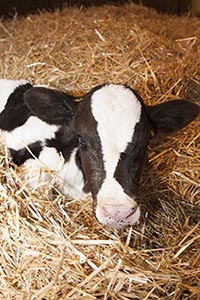 "This is the time of the year where we face the most challenges with raising calves," said Noah Litherland from the University of Minnesota. Cold stress diverts energy away from growth and immune function. Calves that are not growing or losing body weight are delaying the start of first lactation, he explained. If you see a calf shivering, act quickly, because calves don't have many fat reserves.
"This is the time of the year where we face the most challenges with raising calves," said Noah Litherland from the University of Minnesota. Cold stress diverts energy away from growth and immune function. Calves that are not growing or losing body weight are delaying the start of first lactation, he explained. If you see a calf shivering, act quickly, because calves don't have many fat reserves."Don't allow cold stress to push you around," Litherland told the audience at a Professional Dairy Producers of Wisconsin Calf Care Connection program. The goal is to adjust feeding and management to enable calves to grow, resist respiratory and digestive disease and minimize stress.
One way to compensate for cold weather is to feed calves more. This can be done by feeding another meal, feeding more volume or feeding more fat. The importance of consistency - feeding the same amount with the same solids at the same time every day - is even more crucial in cold weather.
Another key is maintaining an environment that protects calves from energy draining cold temperatures. This includes a clean pen with plenty of bedding. Straw is ideal as it allows a calf to nestle down. A calf should be able to lie with their legs entirely covered by straw.
Calves should be sheltered from drafts, but proper ventilation is needed to remove noxious gases, moisture and irritant particles. For calves less than 2 months of age, Litherland recommends a ventilation rate of 15 cfm, or 6 air exchanges per hour.
Additional protection can be offered in the form of a calf jacket. Litherland's rule of thumb is that, if the ground is frozen and the calf is less than three weeks of age, the calf should get a jacket. The straps of the jacket should be adjusted as the calf grows and removed during a health evaluation to fully analyze the calf.
The best way to determine if calves are feeling the affects of winter is to test it out yourself, he said.
"Spend some time in your calf's environment," encourage Litherland. "Take your coat off and hang out in the calf barn for 20 to 30 minutes. How do you feel?" If you are feeling chilled, your calves probably are, too.

The author is an associate editor and covers animal health, dairy housing and equipment, and nutrient management. She grew up on a dairy farm near Plymouth, Wis., and previously served as a University of Wisconsin agricultural extension agent. She received a master's degree from North Carolina State University and a bachelor's from University of Wisconsin-Madison.








